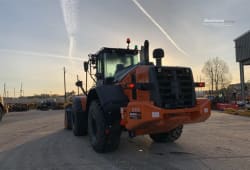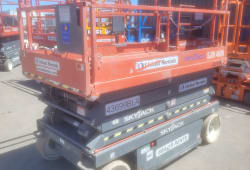10 Considerations When Financing Heavy Equipment
7 Min read
)
October 29, 2022
After several years of uncertainty, the economy is now showing signs of improvement. As a result, many manufacturing and construction companies are getting back to making larger investments to help expand and enhance their own business operations. Financing a new piece of equipment is an important decision; you should take all considerations into account beforehand to ensure that you are preserving your cash and making the most economical decision for your business.
Yet, when it comes to securing new heavy equipment finance construction and, the choice between leasing and obtaining a loan necessitates a comprehensive assessment. The decision-making and application process involves a thorough evaluation of 10 essential considerations to ensure a balance between financial goals, cash flow, and optimal utility.
When financing heavy equipment, you have two options: lease or loan. Each option has its advantages and disadvantages, so it's important to evaluate both options to determine which would balance out your cash flow, usage, and financial goals. Here are 10 considerations to keep in mind when financing heavy and construction equipment financing.
1. Long-Term or Short-Term Needs
The first consideration to make is how long you expect to need the piece of equipment. Is this something you'll need for less than 36 months? If so, your best option, in this case, would be leasing equipment loan for the machine. If you expect to need the new or used equipment for longer than 36 months, applying for a loan is most likely in your best interest.
2. Your Budget
Financing heavy equipment is an ongoing expense, so determining your monthly budget ahead of time is critical. Figuring out how to fit a new piece finance equipment out of heavy equipment financing loans and into your budget will help you avoid future financial pitfalls and plan ahead for additional expenses. In many cases, a lease will come with lower monthly payments, which may make it easier to fit a new piece of equipment into the budget than a larger loan payment.
3. Obsolescence
As with any piece of technology or machinery, the potential for obsolescence is a major factor in deciding if you want to invest in the new equipment. If the equipment becomes outdated during the financing and leasing period, that risk falls on the lessor. However, you may be able to find a financing program that includes technology upgrades in the lease contract.
4. Equipment Versatility
As a business owner, your primary goal is to produce revenue. The best way to do that is to get the most bang for your buck when investing in your supplies and equipment. If the machinery you're considering has limited usage, is only required short-term, or won't be used for multiple projects, the best course of action is to finance construction equipment by leasing own it with a lease. This way, the expense of the financing company will end at the same time your need for the equipment ends. This is more cost-effective than continuing to pay on a loan for a piece of equipment you no longer need or use.
5. Upfront Cost
Knowing how much cash will be required upfront when you finance heavy equipment will help preserve your cash. You should also factor in expenses, including transportation, delivery, installation, testing, training, and other potential costs. Some used heavy equipment loans require a downpayment on signing day, so you'll want to make sure you have the cash available on the day you purchase the equipment.
6. Tax Benefits
Taxes are a frequently overlooked element of financing heavy equipment. When deciding between a loan and a lease to finance heavy equipment, you'll want to consider how the taxes will be handled. A loan will offer a depreciation tax benefit for you, while a lease provides tax benefits to the lessor. They receive lower rent payments and can expense the payment. If your business cannot take advantage of the tax benefit, a lease may be a better option than a loan. This way, you can trade in a depreciated piece of heavy equipment loan to improve cash flow.
7. Impact On Your Business
Most businesses receive an aggregate line of credit from their financial institution or bank to purchase inventory, business enhancements, construction equipment, and additional capital expenses. Depending on the lender, you may be able to conserve working capital but leasing your heavy equipment with an equipment finance provider.
8. Flexible Financing
Leases often offer more flexibility than loans since you can adjust the structure of repayment terms in the agreement. With a loan, you are at the mercy of the lender's stipulations. If flexibility is your top priority, then a lease may be the best option. If you still need the equipment after your lease ends, you have the option to extend your rental, purchase the recruitment, return, or trade construction equipment loan call it in for another machine. If your need for the machine ends when the lease does, you can turn it in, and the expense ceases.
9. Need For Additional Equipment
Suppose you are expanding your business and anticipating growth. In that case, you have the option to sign a master lease that will allow you to obtain several pieces of equipment with the same general terms and conditions. This one financing agreement helps you maintain some flexibility, offers more convenience, and can be renegotiated when you need to add more equipment in the future. There are other equipment leasing options to consider for used equipment as well.
10. Eligibility Requirements
Understanding and managing these factors is crucial when seeking financing for heavy equipment. By ensuring a strong foothold in these areas—such as demonstrating stability in your industry, showcasing a solid business tenure, maintaining healthy revenue figures, and managing a good credit score—businesses can enhance their eligibility and credit scores and improve their chances of securing loans with competitive interest rates, and terms. To get a loan at a competitive rate, you'll want to consider your eligibility requirements. These may vary from lender to lender, but they'll usually consider the following factors:
Industry
How long you've been in business
Annual revenue
Credit score
Making informed decisions regarding heavy equipment financing for construction businesses involves a thorough evaluation of these 10 key factors. Aligning the financing option with your business's specific needs and financial capabilities is crucial for long-term success and sustainable growth in the construction industry. By considering these factors meticulously, businesses can ensure they make the most economically sound decisions, preserving cash and optimizing utility.
Here's a table summarizing the 10 considerations when financing heavy equipment:
:format(webp)) This table provides a concise overview of the key considerations businesses should evaluate when financing heavy equipment. Aligning financing options with specific business needs and financial capabilities ensures prudent decision-making and long-term success in the construction industry.
This table provides a concise overview of the key considerations businesses should evaluate when financing heavy equipment. Aligning financing options with specific business needs and financial capabilities ensures prudent decision-making and long-term success in the construction industry.
Wrapping Up
The successful financing of heavy equipment hinges on a meticulous evaluation of ten pivotal factors. By comprehensively analyzing the duration of need, budget alignment, obsolescence risk, equipment versatility, upfront costs, tax benefits, business impact, flexible financing, expansion requirements, and eligibility criteria, businesses can make informed and prudent decisions. This approach ensures a balance between financial goals, cash preservation, and optimal utilization. Integrating these considerations fosters a path to not just a cost-effective decision but also sustainable growth and success in a dynamic business landscape. Ultimately, informed decision-making empowers businesses to secure the most suitable heavy equipment financing companies and options for their long-term prosperity.














